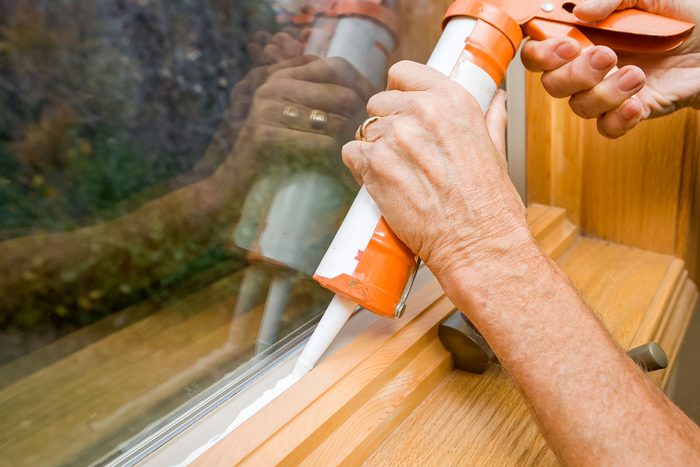What To Know About Window Insulation
Updated: Mar. 03, 2024

To keep your house warm in the winter, you need window insulation. Two experts explain how to best accomplish this and save on energy.
What’s the most common home insulator? The answer may surprise you: Air!
That’s right. Home insulation materials hold small pockets of air and keep them separated from each other. Because air is a poor thermal conductor, these pockets prevent heat from passing through walls and ceilings. This is true for all types of home insulation — fiberglass, cellulose, mineral wool and foam.
The same principle is true for window glass. By itself, glass is a poor insulator. Test it yourself by touching the inside of a window on a cold day. If it’s single-pane glass, it will feel cold. If it’s double- or triple-pane, it won’t.
Insulated glass consists of two or more panes with a gap in between, filled with air or an inert gas like argon or neon. That layer of air or gas does the insulating.
“Insulated windows act as effective barriers against the cold,” says Jeramy Sibley, president of Glass Doctor. “This not only reduces heating costs by improving energy efficiency, but also enhances overall indoor comfort by maintaining a consistent and warmer temperature.”
Jeff Palla, president of Mr. Handyman, adds: “Properly insulating windows for the winter season is a smart investment that can save a homeowner money on heating costs, both in the short and long run.”
How much? Up to $583 per year, according to Energy Star.
On This Page
What Is Window Insulation?
Basically, window insulation is a barrier that prevents heat loss through your windows. Insulated glass is the most obvious example, because it insulates the entire window while preserving transparency. But not all insulation methods do that.
Sometimes gaps around the window are more problematic than the glass. Barriers that prevent airflow through these gaps “enhance overall indoor comfort by maintaining a consistent and warmer temperature,” Sibley says.
Palla offers the following advice for four window insulation strategies that don’t involve replacing the window glass:
- Draft stoppers: These simple fabric tubes sit at the bottom of the window to prevent cold air from leaking inside. “They are most effective when used with double-hung windows, which are most prone to leaking along the bottom,” Palla says.
- Curtains and blinds: “The right window treatments can act like a blanket, covering the glass to keep the cold out,” he says. Palla recommends cellular or honeycomb shades, along with fleece-lined and blackout curtains.
- Caulk and weatherstripping: Use caulk to seal gaps between the window glass and the frame. “Help your windows and doors close more tightly by installing weatherstripping inside the jams and sashes,” Palla says.
- Window film: Whether you DIY the installation or hire a pro, shrink film “seals off drafts and captures an insulating buffer of air,” Palla says.
What Is Insulated Window Glass?
Insulated windows may be made from tempered or safety glass. Because gas molecules between the panes are farther apart than in solid materials, they interact less and transmit less heat energy. This is why insulated windows prevent heat transference.
Insulated double- or triple-pane windows act as effective barriers against the cold, preventing drafts and heat transfer, Sibley says. That isn’t the only factor affecting heat loss, however. The type of window also matters, and Sibley compares four of the most effective styles:
- Single-hung: These feature one moveable framed pane (aka sash) that opens vertically, and one fixed one. The moveable sash does a good job of preventing drafts, although it may need weatherstripping at the bottom. Single-hung windows are good for climate control because they let cold air into areas that may have be too full of heat, providing a balance of warmth and coolness. “They also provide resistance to strong winds in freezing temperatures,” Sibley says.
- Double-hung. These come with two vertically moveable sashes. They work as well as single-hung windows while allowing you to better manage airflow.
- Casement: A casement window opens and closes like a door, usually with one or two locks to seal it shut. “Many consider this the best window for cold weather due to its tight seal,” says Sibley.
- Sliding: These open horizontally. “The sliding window’s seal combined with double- or triple-glass panes is more than sufficient for guarding you and your family from the cold,” says Sibley.
How To Insulate Windows for Winter
Replace all your single-pane windows with double- or triple-pane ones is an expensive proposition that isn’t always practical. Sealing gaps with weatherstripping and caulk will help, but they won’t prevent heat loss through the glass.
Drafty windows let in the cold air, and that can make your favorite corner or even your entire house uncomfortably chilly. Learn to winterize your windows to stay warm this winter.
Window film
Palla suggests installing window film to reinforce the glass against the cold. It’s generally inexpensive and readily available at hardware stores or online.
Bubble wrap
Sibley offers an effective, if slightly less elegant, idea. You’ll need bubble wrap, scissors, a spray bottle full of water and some double-sided tape:
- Measure each window pane and cut bubble wrap to fit, using scissors.
- Moisten the glass by spraying it with water.
- Press the bubble wrap onto the moistened glass. Electrostatic attraction should make it stick.
- Secure the bubble wrap with double-sided tape if it fails to stick to the wet surface.
- Remove the bubble wrap by grasping a corner and pulling it off.
About the Experts
- Jeff Palla is president of Mr. Handyman, a Neighborly company. His 25 years of experience include district manager for Bridge Street Accommodations and multi-unit general manager for Red Roof Inn.
- Jeramy Sibley is president of Glass Doctor, another Neighborly company. It’s a nationwide franchise specializing in window installation and repair.
